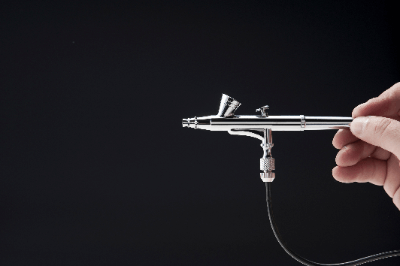What Is an Airbrush?
 An airbrush is a tool used to spray paint/paint using the force of air compressed by a compressor.
An airbrush is a tool used to spray paint/paint using the force of air compressed by a compressor.
Normally, brushes and paint brushes are used to apply paint, but by using an airbrush to spray paint, it is possible to spread the paint evenly and evenly. In addition, since paint is sprayed with finer particles than with canned sprays, it is possible to apply paint from larger surfaces to finer details with a single air brush. It is also possible to create blurring and gradation that cannot be achieved with a brush.
A spray gun is a tool similar to an airbrush, but in most cases, it is a larger tool used primarily for painting.
Uses of Airbrushes
Airbrushes are most commonly used when custom painting of automobiles and motorcycles, painting plastic models and figures, and painting and sculpting artwork.
There are also air brushes used for nail art and confectionery airbrushes used for spraying chocolate, etc.
Principle of Airbrushes
Air is compressed by a compressor, and the negative pressure of the compressed air creates an atom of paint, which is sprayed out through a nozzle at the end of the handpiece, and adheres to the object to be painted.
In airbrushes, the paint is controlled by a button or trigger to release and stop the paint.
How to Choose an Airbrush
There are five things to consider when choosing an airbrush:
1. Handpiece
The handpiece is the part that sprays paint from the tip and is indispensable for airbrushing. There are two main types: button type and trigger type. The button type is also divided into two types: single action and double action.
The button type is held like a pen. The single action type is suitable for beginners because air and paint come out together when the button is pressed, and the amount of paint ejected is constant. In the double-action type, only air comes out when the button is pressed, and paint comes out when the button is pulled back. This type is used for gradation and detailed painting, as the amount of paint sprayed can be adjusted with the fingertip. Button-type sprayers are lightweight and easy to handle, making them suitable for detailed work.
Trigger-type sprayers will spray paint by simply pulling the trigger. Although they are heavier than button-type sprayers, they are more suitable for painting large areas because you can support the sprayer with the palm of your hand. Most trigger-type sprayers are double-action, but single action sprayers are also available, so please check before purchasing.
2. Nozzle Diameter
The nozzle diameter is related to the area to be sprayed with paint.
The smaller the nozzle diameter, the finer and finer the paint can be applied, but if the nozzle diameter is too small, the paint may clog. The amount of paint that can be applied at one time also differs, so the choice depends on the area to be painted.
3. Paint Supply System
There are two types of paint cups: one is an integrated type that is already attached to the handpiece, and the other is a separate type that can be removed by screws or other means. The integrated type is compact and often holds less paint at a time, making it suitable for those who want to do more detailed work.
4. Compressor
There is a wide range of compressors, from industrial to home-use, that are important for airbrushing. The suitable compressor depends on the area to be painted by air brush and the type of paint or pigment to be used.
For painting large areas such as walls, a large high-power compressor is suitable. For small-scale indoor use, such as plastic models and figures, a small, low-noise model is recommended.
5. Regulator
A regulator is a device that adjusts the pressure of high-pressure air coming from a compressor. Also called a pressure reducing valve, in most cases it can be adjusted by turning a knob. It also has the purpose of sending air from the compressor at a constant pressure. The size and specifications of the regulator vary depending on the compressor, so it is necessary to confirm the size and specifications.